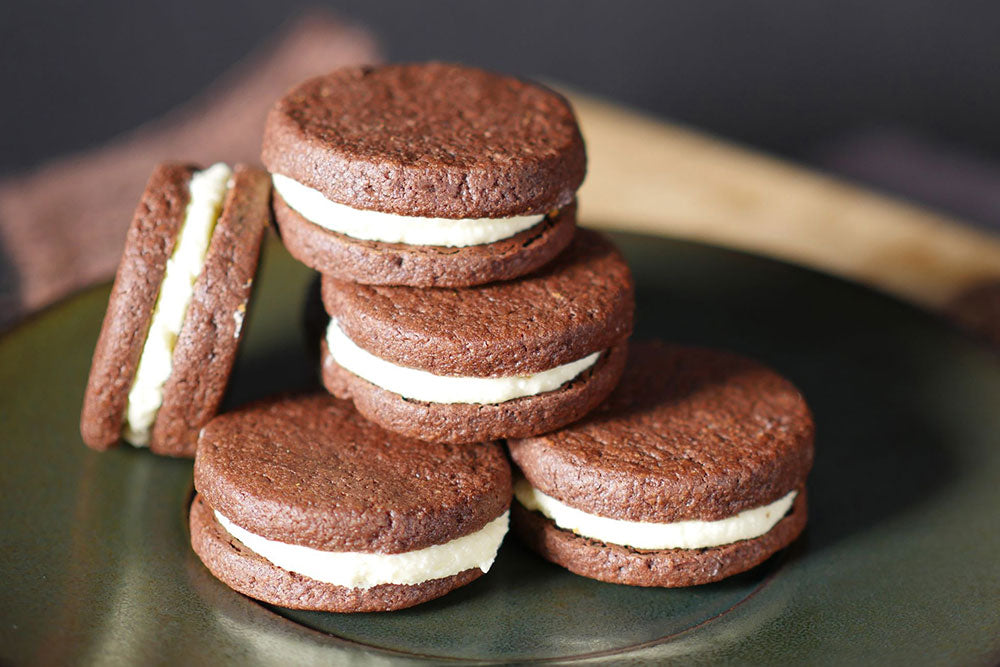
Cocoa Powder 101: When to Use Dutch-Process Vs Natural Cocoa Powder

Pictured: Luker Natural Cocoa Powder 22-24% gives these Chocolate Galleta cookies an intense cocoa flavor and beautiful chocolate color.
Cocoa Powder 101! An ingredient of many uses, colors and flavors, cocoa powder is perfect for a variety of dessert applications, but knowing when to use each one can be somewhat confusing. So, we asked Executive Pastry Chef Jessica Ellington to fill us in on how to use the various types of cocoa powders available so that you can easily give your sweet creations that chocolatey flavor that you're after.
Whether you want to top off a rich chocolate mousse cake with a sprinkle of red powder for added flair, or add a slightly bitter, cocoa flavor to ice cream, our selection of cocoa powders give you many options! Read on to learn about the differences between natural versus Dutch-process cocoa, and how to use them in your recipes.
Natural Vs. Dutch-Process: What's the Difference?

Before we get into the nitty gritty of cocoa powders, let's break down the basics:
Most unsweetened cocoa powders fall under two main groups: natural cocoa powder and Dutch-process cocoa powder. Natural cocoa powders are just that: natural, without any added colorants, which maintains its natural acidity. This results in a stronger, more concentrated and slightly bitter chocolate profile.
On the other hand, Dutch-process cocoa powder is known for its rounder, more mellow chocolate flavor due to a process called alkalization. As a general rule, "the difference between natural and Dutch-process cocoa is acidity," explains Chef Jessica.
Each type has different chemical properties and will react accordingly with certain ingredients, so you'll want to check what the recipe calls for first before choosing between natural or Dutch-process cocoa.
Natural Cocoa Powder

The most popular and versatile form of cocoa powder, natural cocoa powder is non-alkalized and is characterized by its natural reddish-brown color and rich, intense chocolate flavor.
"Natural cocoa powder is naturally acidic and can be reddish in hue sometimes. Generally speaking, red cocoa powders are natural. No coloring agent is being added - that's just the color of some cocoa powders. The reddish hue in baked goods has become desirable over time solely for aesthetic purposes," Jessica says.
Because of the acidic nature of natural cocoa powders, they are normally used in recipes along with baking soda as the ingredients interact with each other and cause pastries to rise. Typically dark and fragrant, natural cocoa powders work great in a wide variety of recipes such as cakes, brownies, cookies, fudge, pudding, and hot chocolate.
Our selection of natural cocoa powders include: Natural Cocoa Powder, 22:24% and Luker Natural Cocoa Powder 22-24%.

Pictured: Chocolate brownies finished with Luker Natural Cocoa Powder for an extra rich cocoa flavor.
Dutch-Process Cocoa Powder

Dutch-process cocoa powders are characterized by rich, dark hues and a more mellow flavor that comes from the Dutch alkalization process. This process starts with cocoa beans that are washed in an alkaline solution, which neutralizes their acidity.
"Dutch-process cocoa powders have been alkalized to remove and reduce the acidity, and reveal a more 'chocolate' forward tasting cocoa that has a rounder flavor. Typically, the darker the Dutch-process cocoa, the less acidic it is. Natural and Dutch-process cocoa are generally not interchangeable in baking recipes," Jessica tells us.
Why is that? Since Dutch-process cocoa is neutral, it does not react with baking soda and so it normally is found in recipes that call for baking powder instead, which will take care of the leavening on its own. Therefore, Dutch-process cocoa powders are generally a little less versatile than their natural counterparts.
Use Dutch-process cocoa powders for recipes such as ganache, mousses, ice creams, sorbets, confectionery coverings, hot chocolates and pastries that call for baking powder instead of baking soda.
Our selection of Dutch-process cocoa powders include Cocoa Powder, Red, 22/24%, Amsterdam Cocoa Powder 22/24%, Extra Brute Cocoa Powder, 22-24%, Plein Arome Cocoa Powder, Extra Red Cocoa Powder, and Cocoa Powder - Extra Noir 10/12.

Pictured: Chocolate mousse cake made with DGF's alkalized Extra Noir Cocoa Powder, featuring a beautifully intense black color.
So, Which Cocoa Powder Should I Choose?
Basically, if a specific recipe doesn't require a leavening agent such as baking powder or baking soda, it really just boils down to personal preference. Sauces, frosting, hot cocoa, ice cream - if it doesn't need to rise, it's completely up to you! In a pinch you can typically use natural cocoa powders in place of Dutch-process, however swapping the other way around is usually more complicated as the recipe most likely needs another acidic ingredient in order to rise.
If you're going for a slightly bitter, strong chocolate profile that can be used across a wide variety of applications, we'd recommend opting for our selection of natural cocoa powders for their versatility and intense, chocolatey flavor.
If you're looking for a more mild, mellow chocolate taste or intensely rich dark color, we'd suggest giving one of our Dutch-process cocoa powders a go.
"When using cocoa in recipes that use no leavening agents such as frostings or chocolate sauces, it really just comes down to taste and color preference. As always, there are exceptions to the rules and these are just general guidelines, but follow them and you'll be well on your way to satisfying that chocolate craving," says Jessica Ellington.
Check out our full selection of available cocoa powders here.
Want to learn how to properly taste the differences between cocoa powders without reading the label? Check out our blog post: How to Taste Cocoa Powder: A Sensory Analysis.
What are your favorite ways to incorporate cocoa powder into your recipes? We want to see your sweet style! Tag us on social @ifiGourmet with #GourmetSweets to get featured on our channels. Happy baking!

Leave a comment